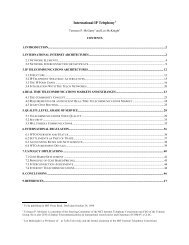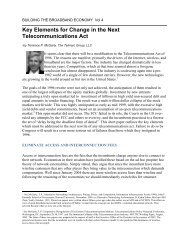progressivism, individualism, and the public ... - Telmarc Group
progressivism, individualism, and the public ... - Telmarc Group
progressivism, individualism, and the public ... - Telmarc Group
Create successful ePaper yourself
Turn your PDF publications into a flip-book with our unique Google optimized e-Paper software.
The <strong>Telmarc</strong> <strong>Group</strong><br />
PROGRESSIVISM, INDIVIDUALISM, AND THE PUBLIC<br />
INTELLECTUAL<br />
Thus, architecture can be defined as <strong>the</strong> conceptual embodiment of a world view, using<br />
<strong>the</strong> commonly understood set of nonstructural elements, based upon <strong>the</strong> available set of<br />
technologies. For example, Gothic architecture was a reflection of <strong>the</strong> ultimate salvation<br />
in God in <strong>the</strong> afterlife, in a building having a roof, walls, floors, <strong>and</strong> windows, <strong>and</strong> made<br />
of stone <strong>and</strong> glass. Romantic architecture was, in contrast, a celebration of man, using <strong>the</strong><br />
same elements, but some employing a few more building materials.<br />
The impact of <strong>the</strong> differences in world view are self evident in <strong>the</strong> embodiments of <strong>the</strong><br />
architecture 193 .<br />
7.1.2 Architectural Alternatives<br />
Is <strong>the</strong>re a natural taxonomy for <strong>the</strong> set of network architecture alternatives? Do <strong>the</strong>se<br />
present limitations on what can be done or are <strong>the</strong>y extensive? Is <strong>the</strong>re a natural limitation<br />
in <strong>the</strong> existing architectures that prevent <strong>the</strong> new technologies from introducing <strong>the</strong> new<br />
paradigms to <strong>the</strong> communications world?<br />
We address <strong>the</strong>se issues in <strong>the</strong> context of several existing network hierarchies. We<br />
present <strong>the</strong>m below:<br />
1. Hierarchical: The current network architectures are structured in a hierarchical<br />
fashion. As we have already indicated, <strong>the</strong>re are substantial historical reason for<br />
this political architecture. Indeed <strong>the</strong> classic structure of Rome <strong>and</strong> even through<br />
<strong>the</strong> Middle Ages has been a strong central Government, <strong>and</strong> in a strong sense this<br />
is Hobbesian. Specifically, we see <strong>the</strong> set of control <strong>and</strong> governance schemes<br />
connecting from a lower level to higher ones <strong>and</strong> back down. A political path may<br />
or may not go horizontally. It may go vertically, all controlled by a single control<br />
at <strong>the</strong> highest level. Hierarchical means a single point of political control.<br />
2. Centralized: A centralized political architecture is similar to a hierarchical<br />
political system in that <strong>the</strong> control function is centralized focus but not a central<br />
person. The pure hierarchical structure is no longer present, but <strong>the</strong>re is a single<br />
point of control <strong>and</strong> management but decision is shared. This is <strong>the</strong> form of<br />
government we have in <strong>the</strong> U.S. It is centralized but not hierarchical, at least most<br />
of <strong>the</strong> time. There are checks <strong>and</strong> balances.<br />
3. Distributed: The distributed architecture has distributed control, distributed<br />
interconnection <strong>and</strong> flat transport alternatives. The network is much less dense<br />
<strong>and</strong> <strong>the</strong> switch is actually co-located with <strong>the</strong> interface. The local town meetings<br />
are typical of this. In a sense this is communitarian anarchy. Small communities<br />
193 See <strong>the</strong> discussions on <strong>the</strong> impact of world view on architecture in Wolfe. In addition see <strong>the</strong> cultural or world view<br />
impact on <strong>the</strong> Gothic architectures in Jantzen <strong>and</strong> in Toy.<br />
Page 193












